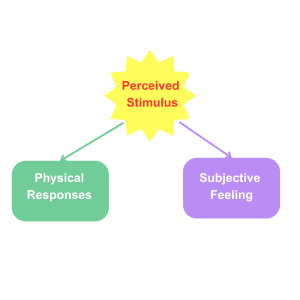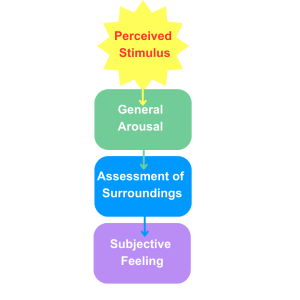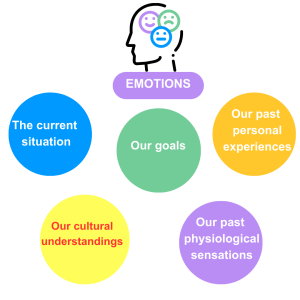3.2 Theories of Emotion
Neuroscience and psychology textbooks typically mention at least three theories of emotions that consider different types of relationships between the physical component and the conscious experience of it (Freberg, 2019; Gluck et al., 2020). While some of these theories have been largely criticized, especially by more recent findings in neuroscience (Feldman Barrett, 2017b), we will briefly outline these three theories here (some in more detail than others) to contextualise emotion research. We will acknowledge some of the criticism of these theories before we look in more detail at the theory of constructed emotions, which has majorly influenced this chapter and eBook overall.
James-Lange (from late 19th Century)

This theory proposes that a stimulus evokes a particular bodily response (including physiological responses like increased heart rate and overt behaviours like clenching a fist and narrowing the eyes, scowling) and then our mind interprets these bodily responses, which again produces a conscious feeling of an emotion (e.g., anger). Related theories are called somatic theories of emotions (theories of emotion based on the central premise that discrete physiological responses to stimuli come first, and these determine or induce our emotions) (Gluck et al., 2020).
The James-Lang theory of emotion is a “bottom-up” (remember that we contrasted bottom-up and top-down processing in the previous chapter type of theory and fits in with the “classical view”. As we have previously mentioned in this eBook, the classical view of emotions holds that emotions are innate, and that our brain comprises emotion circuits that each cause a distinct set of changes in our body, determining a distinct emotion.
One key criticism of the James-Lang theory is, that there is not enough variation in our physiological arousal to create the variety of emotions that people tend to distinguish. Research supports this criticism, including research by Dutton & Aron (1974) on the Capilano Canyon bridge. This research found that male participants interpreted their physiological reactions when crossing this high bridge as sexual attraction to a female person conducting an alleged survey on the bridge.

The James-Lang theory is supported by the Facial Feedback Hypothesis. This theory suggests that facial expressions affect how we feel, e.g., that we can increase the intensity of emotions by expressing it (e.g. that we will feel better when we smile), or that we can reduce the intensity of an emotion by suppressing the display of a negative emotion (e.g. that we will feel more capable of confronting a threatening situation by putting on “a brave face” instead of displaying fear on our face). Some research confirmed the Facial Feedback Hypothesis (see for example Gluck et al., 2020, p. 422).
It is easy to imagine that expressing an emotion might increase the emotion associated with the expression. For example, it would seem that performing the haka not only elicits an emotional response in rugby players but also raises their intensity of the emotion (Freberg, 2019). To get a sense of this, you might want to watch the below Haka performance [2:24]. Watch out for the intensity of the facial expressions!
Research by Ekman (1992) found that smile-inducing manipulations lead to research participants judging cartoons as funnier. However, this research has been challenged by “recent large scale replication attempt by 17 research teams” around the globe, in which only about half of the research teams reported any effect of facial manipulations. While the facial feedback hypothesis has been criticised because of the mixed evidence, it supports the idea that expressing an emotion is unlikely to reduce your feelings, but on the contrary, enhance them. This again has implications for concepts like “catharsis” and “venting”, suggesting that expressing an emotion, e.g. when “having a vent”, may in fact increase the feeling that the venter may have intended to reduce. Indeed, research regarding venting shows that venting does not help to “let off steam” as conventionally assumed, but, on the contrary, that it increases anger (Tanz & Mcclintock, 2017). Research with participants who were prompted to experience anger showed that those participants who were given an opportunity to “let off” their anger by hitting a punching bag experienced more anger and behaved more aggressively than those participants who just sat quietly after the initial experience of anger (Bushman, 2002, cited in Burger, 2019).
Cannon-Bard Theory (from 1927)

This theory proposes that conscious feeling of emotion and bodily responses (including physiological responses like increased heart rate and overt bodily responses such as a particular facial expression and body gestures) occur simultaneously but independent of each other (Gluck et al., 2020). This theory has been majorly challenged by research that demonstrated the link between the physiological response and the subjective feeling.
Two-Factor Theory

This theory was established by Stanley Schachter and Jerome Singer and holds that emotional stimuli provoke bodily responses (unlike the James-Lang theory, these responses are viewed as general rather than emotion-specific arousal) and cognitive appraisal of the situation, which in combination lead to a consciously felt, distinct emotion (Gluck et al., 2020). The theory is based on and supported by a famous experiment where people were unknowingly injected with epinephrine, leading to physiological arousal like an increased heart rate (Kassin et al., 2020). This bodily stage was interpreted by participants differently, depending on the context. Some were paired with accomplices who pretended to be in a happy mood and acted joyful, so the research participants replicated the moods and behaviours of their accomplices. Others were paired with accomplices who acted angrily, and again, research participants adopted the mood and behaviours of these accomplices. The research findings suggest that our environment affects how we interpret otherwise ambiguous bodily sensations (like increased heart rate, which may be associated with many different emotions), which again influences which emotion we are feeling.
Contemporary Theories: The Theory of Constructed Emotions
Advances in neuroscience research have enabled a more nuanced investigation of how the brain processes emotions, which helps explain the origins and purpose of emotions. Please note though that there is still no clear consensus amongst scientists on the question of what emotions are and what their purpose is. Neuroscientist Lisa Barrett Feldman, who we have previously cited in this eBook has developed the “theory of constructed emotions”. This theory differs from the previously noted “classical view” of emotions. To briefly recap, the “classical view” assumes that emotions (or at least some emotions) are inherited and universal across cultures. The classical view has been majorly shaped and supported by the research by Paul Ekman and his team, including his studies on facial expressions.
As an introduction to the theory of constructed emotions, please watch Feldman Barrett’s Ted Talk [18:28]:
As discussed by Feldman Barrett during her talk, the theory of constructed emotions holds that emotions:
- are not something that is built in from birth, but they are “built” through an individual’s socialisation and experience with the people around them, especially during the early years of their life
- are not universal across all humans, but they are shaped by the culture in which we live and may thus differ depending on our cultural context
- don’t have a distinct biological fingerprint but show great variation in terms of how they are being experienced and expressed
- cannot be localised to specific brain structures (even though they involve specialised brain areas)
- don’t follow the same neuronal pathways each time an emotion is experienced (degeneracy).
In the theory of constructed emotions, emotions are viewed as predictions that our brain constructs to give meaning to bodily sensations in each situation. Our mind analyses our physiological sensations (the inside of our body) and the situation (outside of our body) and compares that with our past experiences and expectations (remember the top-down processing to which you were introduced in the previous chapter. Each person’s current and past experiences, which they have gained from life experience, movies, books and learning from others around them, help to give meaning to present situations.
Please see the infographic below to capture the factors that contribute to our experience of emotions.

Extension:
You may also view the scholarly article in which Feldman Barrett (2017b) discusses her theory:
Feldman Barrett, L. (2017b). The theory of constructed emotion: An active inference account of interoception and categorization. Social Cognitive and Affective Neuroscience, 1-23. https://doi.org/10.1093/scan/nsw154
Dr Sam Hardy developed a course on emotions and conflict, in which she considers Lisa Barrett Feldman’s work as well as other theories to discuss what emotions are. To hear Sam’s summary of emotion theories, including Feldman Barrett’s theory of constructed emotions, please view the following video [17:44] (created by Sam Hardy and used with her permission):
To learn more about Lisa Feldman Barrett’s work, you may also wish to watch the following cinematic lecture on how emotions are made [40:01]:

